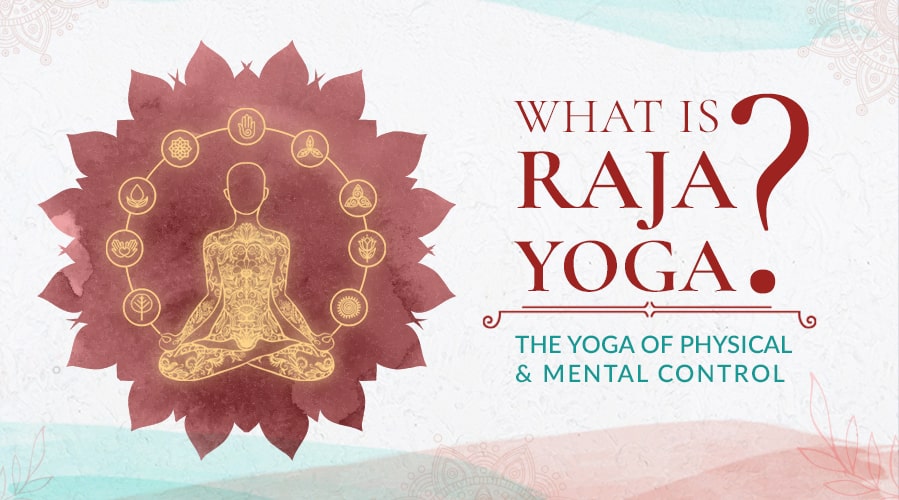Raja Yoga has many names; “Royal Yoga” and “Yoga of Kings” are a few you might have come across. But what does this type of yoga have to do with kings and royals? The truth is, it doesn’t, and it never has…
Keep reading to discover what Raja Yoga means, where it fits in within the greater umbrella of yoga, its benefits, and how you can practice Raja Yoga at home using ancient wisdom from the Eight Limbs of Yoga.
What Does Raja Yoga Mean?
First off, it’s important to understand that Raja Yoga was originally written as "Raj", but due to its pronunciation, it was often misspelled as “Raja” (similar to Ram pronounced as "Rama"). Although the word "Raja” means king, the original spelling “Raaj” actually means control.
Therefore, Raja Yoga is not the Yoga of Kings. Instead, it’s a deeply spiritual practice centered around the control of the Self. In Raja Yoga, you control your body, breath, mind, and desires to remove the ego and reach the state of Samadhi, or enlightenment.
The Four Paths of Yoga
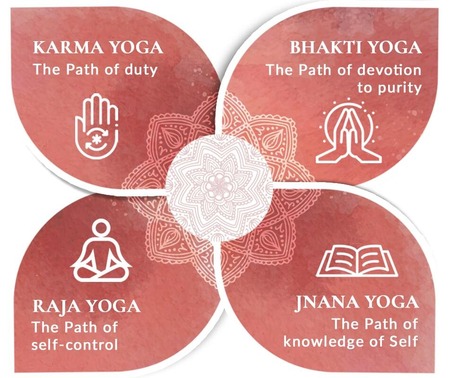
Yoga philosophy presents Four Paths of Yoga which lead to enlightenment. Due to the confusion caused by the ‘Yoga of Kings’ myth, it’s sometimes suggested that Raja Yoga is the superior path. The truth is, all four paths are equal. You can practice any one or more than one, it depends on your personal journey.
The four paths presented in yoga philosophy are:
- Karma Yoga (the Path of Duty)
- Bhakti Yoga (the Path of Devotion)
- Raja Yoga (the Path of Self-control)
- Jnana Yoga (the Path of Knowledge of the Self)
The Origin of Raja Yoga
Tragically, much of the ancient written record of yoga has been lost not only to deteriorating records, but also to deliberate destruction during historic invasions and wars. We do however know that around 2500 years ago, reverent sage Maharishi Patanjali, with the help of his fellow Rishis (scholarly monks), compiled the Raja Yoga Sutras to explain the purpose and the path of Raja Yoga, which we now know as the Yoga Sutras of Patanjali.
Does this Raja Yoga book teach us everything there is to know about this style? No, not even close, but it was never intended to. Compiled for the education of monks and scholars, it can be thought of more as a preliminary course in Raja Yoga. The deeper dive was (and still is) supposed to come from long-term study, possibly with monks who have been passing their knowledge down for thousands of years.
Raja Yoga in Yoga Philosophy
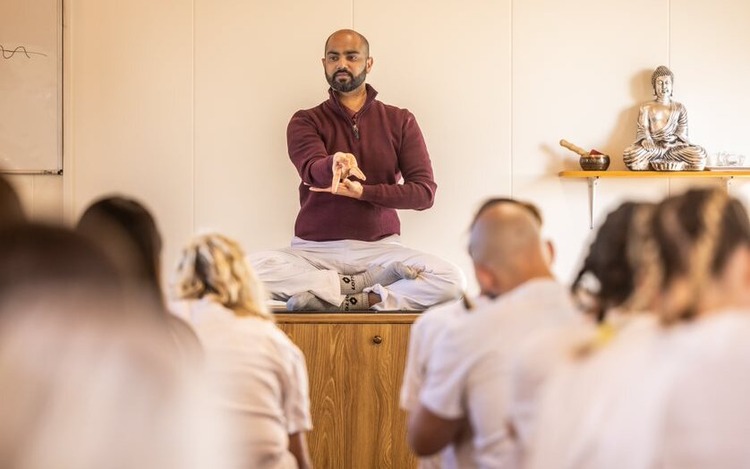
Yoga can seem very confusing. There are so many paths, limbs, Sanskrit words, and meanings that are constantly evolving. Let’s break down the fundamental concepts of Raja Yoga before we explore this path in greater detail.
Yoga
Yoga is an umbrella term used to describe the philosophy or way of life developed by ancient gurus centuries ago. Over the years, various practices have been introduced under this term, including meditation, asana practice, and pranayama to name a few, all of which are designed to help us achieve the fundamental goal of yoga: self-realization and enlightenment.
The Four Paths
In yoga philosophy, the Four Paths are alternative routes you can take during your journey towards self-realization. These paths include: Karma Yoga, Bhakti Yoga, Raja Yoga and Jnana Yoga.
The Eight Limbs
Ashtanga’s Eight Limbs of Yoga is a detailed list of eight steps you can take to move closer to self-realization. These steps are also laid out in the path of Raja Yoga, or Ashtanga Yoga.
Read More: Karma and Dharma: Are You Doing It Right?
Is Raja Yoga the Same as Ashtanga Yoga?
Raja Yoga is Ashtanga Yoga. But, the definition of Raja Yoga is unfortunately not as simple as that. There are two different types of Ashtanga Yoga found today, so it’s important that you understand which one we are referring to here.
In yoga philosophy, Ashtanga Yoga means “eight limbs”, outlining the eight steps practitioners take toward self-realization. However in recent years, Ashtanga has been used to describe Ashtanga Vinyasa Yoga, a set of strictly structured asana sequences developed by Sri Pattabhi Jois in the 20th century.
So, when we refer to Ashtanga Yoga in the context of Raja, we do not mean the physical asana practice, but the ancient yoga philosophy of achieving enlightenment.
Still confused? Read more about the differences between Ashtanga Yoga, Ashtanga Vinyasa, and Raja Yoga.
How to Practice Raja Yoga in 8 Steps
Raja Yoga is considered quite challenging to practice as it requires consistent self-control. Fortunately, each of these 8 steps outlined in the Yoga Sutras of Patanjali can be tailored to fit your life and unique circumstances. It is however important to follow the steps in order as each step prepares you for the next.
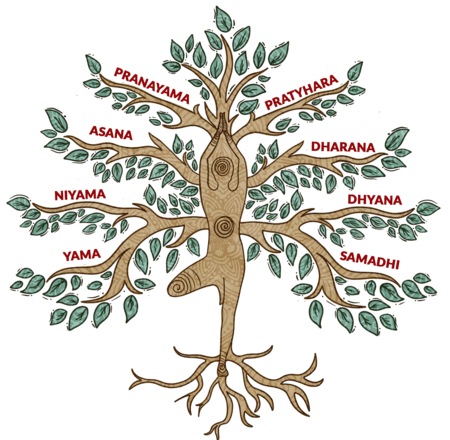
Many people first find yoga through an asana class or breathing exercises. The philosophy of Raja Yoga teaches us that the Yamas and Niyamas should come first and are too important to simply skip. Let’s explore the 8 steps of Raja Yoga in their correct order and how to practice each daily.
1. The Yamas
The Yamas are five areas to improve self-control and purify your intentions. The word “yama”, like “fish”, doesn’t change when it becomes plural form; however, for the convenience of the English-speaking people, we often refer to it as the Yamas.
Yamas are qualities we carry within us, qualities of character we can strive to improve by using self-control and developing pure intentions. In the practice of Raja Yoga, Patanjali identifies five Yamas, but there are likely to be as many as 27, although some sources claim less and others more. The five main Yamas include:
Ahimsa
Ahimsa, meaning non-violence, extends beyond simply not hurting others; it's about being kind to yourself and all forms of life.
For yourself, practicing Ahimsa means taking care of your body and mind, like eating healthily, not smoking, exercising properly, and avoiding negative self-talk.
Practicing non-violence toward others means being considerate to all creatures, like the mosquito in the air and even the smallest creatures swimming in the water we use for tea.
Satya
Meaning truth, Satya is about identifying what is true, and what isn’t. Once you are aware of something true, you can practice speaking your truth and living it.
Another aspect of Satya is not ignoring the truth, which can be very tempting when the facts are unpleasant or don’t fit with our beliefs.
Honesty is an important expression of Satya, and so is learning to express yourself, stand up for what you believe in, and inspire others to speak their truth as well.
Asteya
Simply put, Asteya means not stealing. In Raja Yoga, this isn't just about physical things like not taking things that aren't yours. It's also about fairness, making sure you give as much as you take, whether it's in your job or personal life.
The Asteya Yama is also about not taking away things you can't touch, like someone's happiness by being unkind. We all sometimes want more for ourselves, trying to get the best deal or not giving our best at work and still getting paid. Practicing Asteya means being aware of this and always trying to be fair in everything we do.
Brahmacharya
Brahmacharya is about not overindulging. When we practice Brahmacharya, we make more choices based on what we need, not just what we want. This could mean choosing healthy food over just tasty food, or enjoying a warm shower but not staying in there longer than you need to.
Learning to control ourselves instead of letting our wants control our actions is the essence of Brahmacharya. It helps us find real happiness and peace in our lives.
Aparigraha
Aparigraha is about not being jealous of what others have and collecting material possessions we don't need.
Practicing Aparigraha can be simple. Before buying something, ask yourself if you really need it or just want it. If you don't need it, think twice about buying it. If it seems necessary, consider if you can manage without it. This approach helps lead to a simpler, more content life.

Discover yoga philosophy principles to boost your happiness
Get free access to a life-changing series of 6 webinars with Arhanta Yoga founder Ram Jain
2. The Niyamas
Once you have understood and practiced the Yamas, you are ready for the Niyamas. The Yamas are related to personal qualities or character, while the Niyamas relate to habits. Again, there are actually many more, but we will focus on the five listed in the Sutras of Patanjali.
Saucha
Pronounced “Shoucha”, Saucha means cleansing. This applies to both the mental and the physical. The physical side of Saucha includes hygiene habits like cleaning your teeth and your house, as well as the internal cleansing techniques, the Shat Kriyas.
Mental cleanliness refers to clearing the mind of negative intentions, damaging thoughts, and destructive emotions. Just like physical cleanliness, this means developing a regular habit for hygiene. That might mean regular prayer, mindfulness, or using positive affirmations, or mantras.
Santosha
Santosha is all about finding contentment and being grateful for what we have. It doesn't mean you have to stick with what you have and never change. Sometimes, being content means leaving a bad situation to make something better for yourself. It's okay to be thankful for what you have now and still look forward to changing and growing in the future.
Tapas
Tapas means self-discipline. Practicing this Niyama is about limiting yourself to break free from bad habits. While monks might do this in extreme ways, like giving up all their materials possessions or meditating in cold caves, you can easily practice Tapas in everyday life by saying no to temptations and sticking to good choices.
Ishvara Pranidhana
Ishvara Pranidhana is the practice of staying connected with your god, whoever that may be. It's important to remember to connect with your god in good times and in times of need. This connection helps us find our purpose and see the incredible links between everything in the world.
Swadhyaya
Swadhyaya means self-study. It's about understanding yourself and your beliefs to find a deeper sense of self and direction. A simple way to do this is to spend some time each day reflecting on who you are, what you feel, why you feel that way, and why you do the things you do.
3. Asana
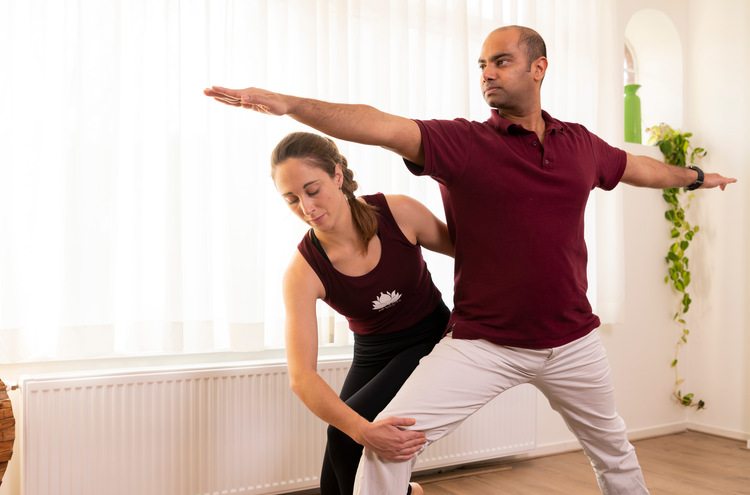
Asana is the physical part of yoga typically seen in yoga studios and classes. It’s usually assumed that ‘asana’ means pose or posture. The word actually means a steady and comfortable state of mind and body.
Asana practice was first created by monks to keep their bodies healthy and balanced. They generally didn't eat or drink much and spent most of their time meditating in a seated position. The original asanas were therefore designed to support their internal organs and glands without using too much energy.
Nowadays, the focus of asana practice is more on physical appearance, fitness, flexibility and the anatomical perfection of a pose. But when you're working on self-awareness, it's better to think of yoga asanas as a way to cleanse and bring health to your body.
The aim of practicing yoga poses in Raja Yoga is to be able to achieve a steady and comfortable state while in the posture, but it’s easier said than done. Most of us are able to enter the asana state for a few minutes in a class, or perhaps none at all.
While there are no yoga postures offered in the Yoga Sutras, Vyasa, the original commentator on the Yoga Sutras, provided a number of yoga asanas to help us enter this state. These included seated positions like Padmasana (Lotus position), Virasana (Hero Pose), and Svastikasana (Auspicious Pose), and Dandasana (Staff Pose), as well as Shavasana (Corpse Pose).
4. Pranayama
The fourth step in Raja Yoga is Pranayama. Pranayama is not breathing exercises, but an umbrella term used to describe yogic breathing techniques that boost our prana, or life-force energy. There's a quote in the Shiva Samhita that says life isn't about how many days you live, but how many breaths you take. Look at dogs, who breathe fast and have shorter lives, compared to turtles that breathe slowly and live much longer.
When you practice pranayama, you slow down your breath and conserve your life-force energy. This can have remarkable benefits for your health and well-being, helping reduce stress, improve bodily functions, and even slow down aging. You can try some simple breathing exercises like Ujjayi Breath to get started and learn more about the power of breath and pranayama.
5. Pratyahara
Pratyahara means withdrawal from the senses or not overwhelming them. It's like giving your senses a break. This can be done in different ways, like using a flotation tank for sensory deprivation or just by cutting down on sensory overload in your daily life.
One way you can quiet the senses and turn your focus inward is through Bhramari Pranayama and Shanmukhi Mudra. This position helps block out external sensory input, giving you a sense of quiet and calm. Here's how to do it:
- Use your thumbs to close your ears.
- Then, close your eyelids gently with your index fingers.
- Lightly touch your nostrils with your middle fingers.
- Ring fingers rest above your upper lip and pinky fingers below your lower lip.
- From here, breathe in through your nostrils and engage your vocal cords slightly to make a snoring sound.
- After one deep inhale, exhale for as long as you can.
- Create a high-pitched humming sound from your nose as you exhale, remembering to hold your Shanmukhi Mudra.
- Create this hum from your nose and visualize piercing your Third Eye Chakra with the sound.
- Repeat six to eight times and close with an exhalation.
6. Dharana
After learning to control our minds and senses, we can begin to work on concentration, which in yoga is known as Dharana.
In Dharana, we focus on just one thing using the yoga gazing technique Drishti. In Drishti, you gaze at any fixed point to deepen your focus and reach a new level of concentration. This could be your breath, a candle flame, a special word, or mantra. You might also try focusing on different parts of your body, one at a time, or listen closely to a teacher's voice during a guided relaxation.
These activities are often mistaken for meditation, but they're actually ways to practice concentrating. Learning to concentrate is a vital skill to achieve a true meditative state.
7. Dhyana
Once you get the hang of deepening your focus through Dharana, you can start to turn that focus inward, towards yourself in Dhyana, otherwise known as meditation. Focusing on yourself is tricky because it's not something you can see or hear in the usual way. It's more about feeling an awareness, like sensing a presence.
Reaching this level of awareness needs a lot of concentration and stillness. It's similar to trying to see something under water. If there's even a small ripple on the surface, it can be hard to see what's beneath. Dhyana in Raja Yoga, or meditation, is about calming your mind and body to a point where you can turn your attention inward and really connect with your Self.
8. Samadhi
Samadhi is the final step in the Yoga Sutras and the culmination of all 7 steps or practices. It happens when you reach such a deep level of self-awareness in meditation that you completely disconnect from the outside world and fully connect with your inner Self.
In this state, you experience true freedom and pure joy. By connecting deeply with your inner self, you achieve enlightenment—the fundamental aim of yoga.
Raja Yoga Benefits
Raja Yoga might seem complicated at first, but this deeply spiritual practice offers numerous benefits that make each step worth it.
The Yamas and Niyamas work to purify your character. Asanas and Pranayama cleanse your body and mind. Pratyahara helps you handle your senses better, and Dharana gives you control over your mind. When all these aspects are aligned in your life, you can focus on meditation, or Dhyana, aiming for Samadhi—the ultimate state of self-awareness and enlightenment.
Therefore, each of the 8 limbs of Raja Yoga brings its own benefits, but the path ultimately helps practitioners detach from worldly illusions, their ego, and negativity. This develops a deeper understanding of the Self, helping us grasp inner peace and ultimate bliss.
Final Thought
This journey towards Samadhi in Raja Yoga leads to a life filled with intention, contentment, and peace. To get there, you need dedication and consistent effort. It's not easy, but the reward is worth it. The Path of Self-control offers a clear route to achieve this.

Discover yoga philosophy principles to boost your happiness
Get free access to a life-changing series of 6 webinars with Arhanta Yoga founder Ram Jain

